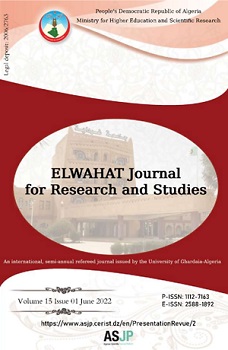The Changing Structure of the US banking Business Model: Deregulation, Innovation and the financial crisis
Abstract
This article is centered on the idea that the changing structure of the US Banking Business Model offers an explanation to the recent financial crisis. It highlights the active role often played by banking regulationsand laws in the US as the roots of these radical changes as well as the rise of financial innovation especially the process of securitization as the beating heart of the new model. A particular attention is given to the responsive measures after the financial crisis especially the introduction of new regulations to restrain the risky behavior of the banking industry and their ability to transform the dominant banking model from an “Originate-to-Hold model” to the new “Originate-to-Distribute” one. The article is divided into two Sections, Section1 represent an attempt to discuss the importance of banking regulation and deregulation in changing the banking industry and the business model in the US. Section2 tries to explain the rise of financial innovations and the mechanism of securitization that underpinned the new model of banking development, then it takes a good look at the financial crisis and how the government responded to this crisis and what’s the effect in the present day on the business model of banks.
Key Words-
US Banking Model, Deregulation, financial innovations, Securitization, financial crisis.
References
-The earlier history of banking in the united states defined by multiple attempts from the government to control the issue of bank notes and the expansion of private banking, through the creation of a tow major banks that were described as a prototype to the modern central banking ( the first bank of the united states 1791 ; and the second Bank of the united states 1816); For more insight see: (David J.Cowen, Dec 2000, the first bank of the United States and the security market crash of1792), (Ralph C.H.Catteral, 1911, the successes and failures of the first and the second banks of the united states).
-The McFadden Act: enacted in 1927, aimed to give the national banks competitive advantage with state chartered banks by permitting the national banks to extent permitted by state law.
-Public Law 73-6, “Banking Act of 1933(Glass-Steagall Act)”, 1933, p.30 URL:https://fraser.stlouisfed.org/scribd/?title_id=991
- Ibid., p.30
- Ibid., p.2
-Ibid., p.7
-US Code “Title 12, Chapter 17 §1841” URL:https://www.law.cornell.edu/uscode/text/12/1841
- Hall, George R. “Bank Holding Company Regulation”, Southern Economic Journal, Vol.31, No.4, 1965, p.342
-Board of Governors of the Federal Reserve System “Thirtieth Annual Report of the Board of Governors of the Federal Reserve System”, 1943, p.36. URL: https://fraser.stlouisfed.org/title/117#! 2501
-Ibid., p.36
-Ibid., p.36
-Ibid., p.36
-The Clayton Antitrust Act of 1914, it was the first modern law with the aim of targeting the anticompetitive practices like (monopolies, cartels…etc.)
-Stevens, W. H. S. “The Clayton Act” The American Economic Review, vol.5, no.5, 1915, p.40. URL: http://www.jstor.org/stable/74
-“Transamerica. The Banking Holding Company Problem” Stanford Law Review, vol.1, no.4, 1949, p.658. URL: http://www.jstor.org/stable/1226352
-The first ever MMMF was launched in 1973 by tow brilliant managers at the Teachers Insurance and Annuity Association (Henry B.R.Brown and Bruce R.Bent) and it was called Reserve Fund.INC, See: Robert D.Hershey JR., (overnight mutual funds for surplus assets), the New York Times, Jan.7, 1973.
-Regulation Q is a provision under which the FED prohibited banks and S&L thrift institutions from paying higher interest rates on time and savings deposit, in another term it is a provision to control interest rates. (Friedman, 1970, p. 32) Asserted that: “the control of interest rates by commercial banks is not a useful or effective instrument of monetary policy. It has unpredictable effects on aggregate demand, complicates the interpretation and operation of the effects of other policy actions…the sooner it is terminated as an instrument of monetary policy the better”; for the pro Q regulation in monetary policy See: (Jaffee, 1969).
-Allen, Paul R., and William J. Wilhelm. “The Impact of the 1980 Depository Institutions Deregulation and Monetary Control Act on Market Value and Risk: Evidence from the Capital Markets.” Journal of Money Credit and Banking, vol.20, no.3, 1988, p.367. URL: http://www.jstor.org /stable/1992262
-DIDMCA: Depository Institutions Deregulation and Monetary Control Act.
-Statistical Generator of the FDIC open webpage. URL: https:// www5 .fdic.gov/hsob/HSOBSummaryRpt.asp?BegYear=1980&State=1&Header=0
-Public Law 97-320 "Garn-St Germain Depository Institutions Act of 1982”, 1982,p.1 (96 STAT.1469) URL: https://www.gpo.gov/fdsys/pkg/STATUTE-96/pdf/STATUTE-96-Pg1469.pdf
-Ibid., p.1(96 STAT.1469)
-Ibid., p.28(96 STAT.1496)
-Ibid., p.33(96 STAT.1501)
-NOW Accounts: Negotiable Order of Withdrawal Accounts.
-Comett, Marcia Millon, and Hassan Tehranian. “An Examination of the Impact of the Garn-St. Germain Depository Institutions Act of 1982 on Commercial Banks and Savings and Loans” The Journal of Finance, vol.45, no.1, 1990, pp.98-99. URL: http://www.jstor.org/stable/2328811
-Berger, Allen N., et al. “The Transformation of the U.S. Banking Industry: What a Long, Strange Trip It’s Been.” Brookings Papers on Economic Activity, vol. 1995, no.2, 1995, p.81. URL: http://www.jstor.org /stable/2534612
- Federal Reserve System“Code of federal Regulations: 1985-1999”, p.595 URL: https://books.google.dz/books?id=xjCo5ZTP6hEC&pg=PA595&lpg=PA595&dq=the+Douglas+Amendment+(12+U.S.C.+%C2%A71842+D).&source=bl&ots=RPi6QvDV2t&sig=KdKO4tF4gJXSg_uetOCPAIuxPUY&hl=fr&sa=X&ved=0ahUKEwiFvofMyYzYAhXKNxQKHXCBB2gQ6AEIMDAB#v=onepage&q=the%20Douglas%20Amendment%20(12%20U.S.C.%20%C2%A71842%20D).&f=false.
-Public Law 103-328 “The Riegle-Neal Interstate Banking and Branching Efficiency Act”,1994, p.2 (108 STAT.2339)
URL:https://fraser.stlouisfed.org/scribd/?title_id=1048&filepath=/files/docs/historical/congressional/riegle-neal-interstate-banking-1994.pdf
-Ibid., p.8 (108 STAT.2345)
-Pillof, Steven J. “Bank Mergers Activity in the United States, 1994-2003.” Board of Governors of the Federal Reserve System, May.2004, p.4. URL: http://federalreserve.org/ pubs/Staffstudies/2000-present/ss176.pdf
- Buchman, John A. “Can Community Banks Survive? What the Interstate Banking Act Will Mean.” Business Law Today, vol.5, no.3, 1996, p.44. URL: http://www.jstor.org/stable/ 23290217
-See: page 5 of this article.
-Public Law 106-102, “GRAMM-LEACH-BLILEY ACT”, 1999, p.5 (113 STAT.1341) URL: https://www.gpo.gov/fdsys/pkg/PLAW-106publ102/pdf/PLAW-106publ102.pdf
-Ibid., pp.5-6 (113 STAT.1341-1342)
-Section 103 (4) of GLBA reads as fallow : “the following activities shall be considered to be financial in nature : (A)lending, exchanging, transferring, investing for others, or safeguarding money or securities (B)insuring, guaranteeing, or indemnifying against loss, harm, damage, illness, disability, or death, or providing and issuing annuities…(C)providing financial, investment, or economic advisory services, including advising an investment company(D)issuing or selling instruments representing interests in pools of assets permissible for a bank to hold directly(E)underwriting, dealing in, or making a market in securities…”.
-Public Law 106-102, “GRAMM-LEACH-BLILEY ACT”, 1999, p.6 (113 STAT.1342) URL: https://www.gpo.gov/fdsys/pkg/PLAW-106publ102/pdf/PLAW-106publ102.pdf
-Ibid., p.71 (113 STAT.1407)
-Ibid., p.63 (113 STAT.1399)
-Van Horne, James C. “Of Financial Innovation and Excesses.” The Journal of Finance, vol.40, no.3, 1985, p.621. URL: http://www.jstor.org/ stable/2327784
-Silber, William L. “The Process of Financial Innovation.” The American Economic Review, vol.73, no.2, 1983, pp.89-90. URL: http://www.jstor.org /stable/1816820
-Miller, Merton H. “Financial Innovation: The Last Twenty Years and the Next.” The Journal of Financial and Quantitative Analysis, vol.21, no.4, 1986, p.461. URL: http://www.jstor.org/stable/2330693
-Buffet, Warren “Warren Buffet on Derivatives”, p.2. http://www.fintools.com/docs/Warren%20Buffet%20on%20Derivatives.pdf
- The Code of Federal Regulations “Title 12, Chapter V, Part 563, Subpart F, Section 563.172.” URL: https://www.gpo.gov/fdsys/pkg/CFR-2016-title12-vol6/pdf/CFR-2016-title12-vol6-sec563-172.pdf
- Tsetsekos, George, and PanosVarangis. “Lessons in Structuring Derivatives Exchanges.” The World Bank Research Observer, vol.15, no.1, 2000, p.86. http://www.jstor.org/stable/3986502
-International Options Market Association “Derivatives Market Survey of 2007”, p.9.URL:https://www.world-exchange.org
-Ibid., p.9
- Dodd, Randall. “Consequences of Liberalizing Derivatives Markets.” Financial Policy Forum, Washington D.C., 2003, p.8. http://www.policydialogue.org/files/publications/Liberalizing_Derivatives_Markets_Dodd.pdf
-Ibid., pp.8-9
-Originate-to-Hold model is when a bank makes loans with the intention of keeping them throughout the process of maturity.
- Originate-to-Distribute model is when a bank initiate credits and then transfers (Sell) them to the markets (different institutions and investors) using the securitization process.
-See: Steven L.Schwarcz. “Structured Finance: A Guide to Asset Securitization.” 2nd edition, New York: Practicing Law Institute, p.3
-Leveson, Irving. “Globalization of Financial Services.” Business Economics, vol.22, no.4, 1987, p.41. URL: http://www.jstor.org/stable/23484256
- Karaoglu, Emre N. “Regulatory Capital and Earnings Management in Banks: The Case of Loan Sales and Securitizations.”, FDIC Center for Financial Research, University of Southern California, 2005. URL:https://papers.ssrn.com/sol3/papers.cfm?abstract_id=722982
-“Investment Company Act”, Federal Register, Vol.57, No.229, p.56248 https://www.sec.gov/rules/concept/1992/ic-19105.pdf
- Kindleberger, Charles P. “Manias, Panics and Crashes: a History of Financial crisis.”, 5th edition, Wiley and Sons, New York, 2005, p.114.
- Atkinson, Tyler. and al. “How Bad Was It? The Costs and Consequences of the 2007-09 Financial Crisis.” Dallas FED, Staff papers, N°.20, 2013. URL:http://www.dallasfed.org/-/Media/Documents/research/staff/staff1301.ashx
-a high-risk loans to borrowers with (no income, no job and no assets)
-See :https://www.treasury.gov/initiatives/financial-stability/TARP-Programs/Pages/default.aspx
-Stiglitz, Joseph. “Nobel Laureate Joseph Stiglitz: Bail Out Wall Street Now, Change Terms Later.” Democracy Now!, October 02, 2008. URL:https://www.democracynow.org/2008/10/2/nobel_laureate_joseph_stiglitz_bailout_wall
- Felkerson, James. “29,000,000,000,000$: a Detailed Look at the Fed’s Bailout by Funding Facility and recipient.” University of Missouri-Kansas City,Working Paper, No.698 2011. URL: http://www.levyinstitute.org/pubs/wp_698.pdf
-Stiglitz, Joseph. “The Fruit of Hypocrisy: Dishonesty in the Finance Sector dragged here, and Washington looks ill-equipped to guide us out.” The guardian, September 16, 2008. Url:https://www.theguardian.com/commentisfree/2008/sep/16/economics.wallstreet
-Public Law 111-203, “DODD-FRANK WALL STREET REFORM AND CONSUMER PROTECTION ACT”, 2010,p.50 (124 STAT.1424)
URL: https://www.treasury.gov/about/organizational-structure/offices/Documents/Dodd%20Frank%20Act.pdf
-Board of Governors of the Federal Reserve System “Resolution Plan Assessment Framework and Firm Determination (2016).” , Washington, 2016. URL: https://www.federalreserve.gov/newsevents/pressreleases/files/bcreg20160413a2.pdf
- Public Law 111-203, “DODD-FRANK WALL STREET REFORM AND CONSUMER PROTECTION ACT”, 2010,p.270 (124 STAT.1621)
URL: https://www.treasury.gov/about/organizational-structure/offices/Documents/Dodd%20Frank%20Act.pdf
- Bao, Jack and al. “The Volcker Rule and Market-Making in Times of Stress.” Federal Reserve Board, Washington, 2016, p.29 URL:https://www.federalreserve.gov/econresdata/feds/2016/files/2016102pap.pdf
-Public Law 111-203, “DODD-FRANK WALL STREET REFORM AND CONSUMER PROTECTION ACT”, 2010,p.259 (124 STAT.1633)
URL: https://www.treasury.gov/about/organizational-structure/offices/Documents/Dodd%20Frank%20Act.pdf
-Ibid., p.258 (124 STAT.1632)
-Ibid., pp.20-21 (124 STAT.1394-1395)
- Ibid., pp.21-22 (124 STAT.1395-1396)
-Ibid., p.80 (124 STAT.1454)
- Office of Financial Research “Financial Stability Report of 2016.” 2016, p.5 URL: https://www.financialresearch.gov/financialstabilityreports/files/OFR_2016_Financial-Stability-Report.pdf
-Ibid., p.68
-Ibid., p.72
- Sarin, Natasha. And Lawrence H.Summers “Have big banks gotten saver?” Brooking Papers on Economic Activity, 2016 URL: https://www.brookings.edu/wp-content/uploads/2016/09/2_sarinsummers.pdf
-See: Acharya, Viral v. and al “Measuring Systemic Risk” The Review of Financial Studies, Vol.30, No.1, 2017, pp.2-47
URL: https://academic.oup.com/rfs/article/30/1/2/2682977
- Sarin, Natasha. And Lawrence H.Summers “Have big banks gotten saver?” Brooking Papers on Economic Activity, 2016, p.55 URL: https://www.brookings.edu/wp-content/uploads/2016/09/2_sarinsummers.pdf
- Office of Financial Research “Financial Stability Report of 2016.” 2016, p.73
URL:https://www.financialresearch.gov/financialstabilityreports/files/OFR_2016_Financial-Stability-Report.pdf






